Information Extraction
Information extraction is the process of automatically extracting structured information from unstructured text data.
Papers and Code
Benchmarking Agentic Systems in Automated Scientific Information Extraction with ChemX
Oct 01, 2025



The emergence of agent-based systems represents a significant advancement in artificial intelligence, with growing applications in automated data extraction. However, chemical information extraction remains a formidable challenge due to the inherent heterogeneity of chemical data. Current agent-based approaches, both general-purpose and domain-specific, exhibit limited performance in this domain. To address this gap, we present ChemX, a comprehensive collection of 10 manually curated and domain-expert-validated datasets focusing on nanomaterials and small molecules. These datasets are designed to rigorously evaluate and enhance automated extraction methodologies in chemistry. To demonstrate their utility, we conduct an extensive benchmarking study comparing existing state-of-the-art agentic systems such as ChatGPT Agent and chemical-specific data extraction agents. Additionally, we introduce our own single-agent approach that enables precise control over document preprocessing prior to extraction. We further evaluate the performance of modern baselines, such as GPT-5 and GPT-5 Thinking, to compare their capabilities with agentic approaches. Our empirical findings reveal persistent challenges in chemical information extraction, particularly in processing domain-specific terminology, complex tabular and schematic representations, and context-dependent ambiguities. The ChemX benchmark serves as a critical resource for advancing automated information extraction in chemistry, challenging the generalization capabilities of existing methods, and providing valuable insights into effective evaluation strategies.
Macroscopic EEG Reveals Discriminative Low-Frequency Oscillations in Plan-to-Grasp Visuomotor Tasks
Oct 21, 2025The vision-based grasping brain network integrates visual perception with cognitive and motor processes for visuomotor tasks. While invasive recordings have successfully decoded localized neural activity related to grasp type planning and execution, macroscopic neural activation patterns captured by noninvasive electroencephalography (EEG) remain far less understood. We introduce a novel vision-based grasping platform to investigate grasp-type-specific (precision, power, no-grasp) neural activity across large-scale brain networks using EEG neuroimaging. The platform isolates grasp-specific planning from its associated execution phases in naturalistic visuomotor tasks, where the Filter-Bank Common Spatial Pattern (FBCSP) technique was designed to extract discriminative frequency-specific features within each phase. Support vector machine (SVM) classification discriminated binary (precision vs. power, grasp vs. no-grasp) and multiclass (precision vs. power vs. no-grasp) scenarios for each phase, and were compared against traditional Movement-Related Cortical Potential (MRCP) methods. Low-frequency oscillations (0.5-8 Hz) carry grasp-related information established during planning and maintained throughout execution, with consistent classification performance across both phases (75.3-77.8\%) for precision vs. power discrimination, compared to 61.1\% using MRCP. Higher-frequency activity (12-40 Hz) showed phase-dependent results with 93.3\% accuracy for grasp vs. no-grasp classification but 61.2\% for precision vs. power discrimination. Feature importance using SVM coefficients identified discriminative features within frontoparietal networks during planning and motor networks during execution. This work demonstrated the role of low-frequency oscillations in decoding grasp type during planning using noninvasive EEG.
PRNet: Original Information Is All You Have
Oct 10, 2025
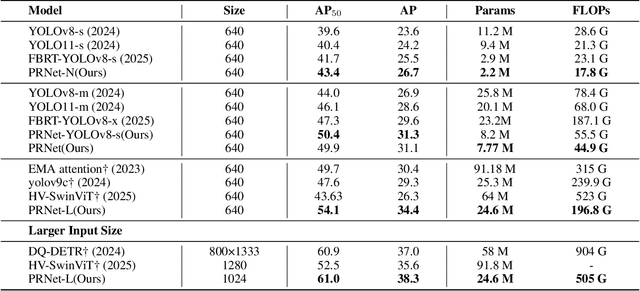

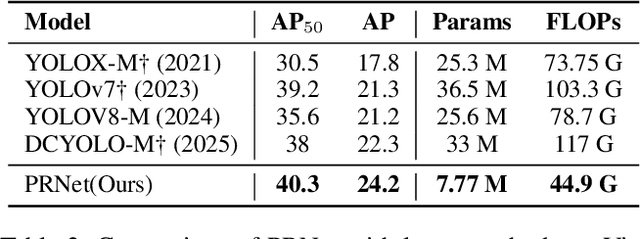
Small object detection in aerial images suffers from severe information degradation during feature extraction due to limited pixel representations, where shallow spatial details fail to align effectively with semantic information, leading to frequent misses and false positives. Existing FPN-based methods attempt to mitigate these losses through post-processing enhancements, but the reconstructed details often deviate from the original image information, impeding their fusion with semantic content. To address this limitation, we propose PRNet, a real-time detection framework that prioritizes the preservation and efficient utilization of primitive shallow spatial features to enhance small object representations. PRNet achieves this via two modules:the Progressive Refinement Neck (PRN) for spatial-semantic alignment through backbone reuse and iterative refinement, and the Enhanced SliceSamp (ESSamp) for preserving shallow information during downsampling via optimized rearrangement and convolution. Extensive experiments on the VisDrone, AI-TOD, and UAVDT datasets demonstrate that PRNet outperforms state-of-the-art methods under comparable computational constraints, achieving superior accuracy-efficiency trade-offs.
Acquisition of interpretable domain information during brain MR image harmonization for content-based image retrieval
Oct 16, 2025Medical images like MR scans often show domain shifts across imaging sites due to scanner and protocol differences, which degrade machine learning performance in tasks such as disease classification. Domain harmonization is thus a critical research focus. Recent approaches encode brain images $\boldsymbol{x}$ into a low-dimensional latent space $\boldsymbol{z}$, then disentangle it into $\boldsymbol{z_u}$ (domain-invariant) and $\boldsymbol{z_d}$ (domain-specific), achieving strong results. However, these methods often lack interpretability$-$an essential requirement in medical applications$-$leaving practical issues unresolved. We propose Pseudo-Linear-Style Encoder Adversarial Domain Adaptation (PL-SE-ADA), a general framework for domain harmonization and interpretable representation learning that preserves disease-relevant information in brain MR images. PL-SE-ADA includes two encoders $f_E$ and $f_{SE}$ to extract $\boldsymbol{z_u}$ and $\boldsymbol{z_d}$, a decoder to reconstruct the image $f_D$, and a domain predictor $g_D$. Beyond adversarial training between the encoder and domain predictor, the model learns to reconstruct the input image $\boldsymbol{x}$ by summing reconstructions from $\boldsymbol{z_u}$ and $\boldsymbol{z_d}$, ensuring both harmonization and informativeness. Compared to prior methods, PL-SE-ADA achieves equal or better performance in image reconstruction, disease classification, and domain recognition. It also enables visualization of both domain-independent brain features and domain-specific components, offering high interpretability across the entire framework.
Advancing Brain Tumor Segmentation via Attention-based 3D U-Net Architecture and Digital Image Processing
Oct 21, 2025In the realm of medical diagnostics, rapid advancements in Artificial Intelligence (AI) have significantly yielded remarkable improvements in brain tumor segmentation. Encoder-Decoder architectures, such as U-Net, have played a transformative role by effectively extracting meaningful representations in 3D brain tumor segmentation from Magnetic resonance imaging (MRI) scans. However, standard U-Net models encounter challenges in accurately delineating tumor regions, especially when dealing with irregular shapes and ambiguous boundaries. Additionally, training robust segmentation models on high-resolution MRI data, such as the BraTS datasets, necessitates high computational resources and often faces challenges associated with class imbalance. This study proposes the integration of the attention mechanism into the 3D U-Net model, enabling the model to capture intricate details and prioritize informative regions during the segmentation process. Additionally, a tumor detection algorithm based on digital image processing techniques is utilized to address the issue of imbalanced training data and mitigate bias. This study aims to enhance the performance of brain tumor segmentation, ultimately improving the reliability of diagnosis. The proposed model is thoroughly evaluated and assessed on the BraTS 2020 dataset using various performance metrics to accomplish this goal. The obtained results indicate that the model outperformed related studies, exhibiting dice of 0.975, specificity of 0.988, and sensitivity of 0.995, indicating the efficacy of the proposed model in improving brain tumor segmentation, offering valuable insights for reliable diagnosis in clinical settings.
Vision-Centric Activation and Coordination for Multimodal Large Language Models
Oct 16, 2025Multimodal large language models (MLLMs) integrate image features from visual encoders with LLMs, demonstrating advanced comprehension capabilities. However, mainstream MLLMs are solely supervised by the next-token prediction of textual tokens, neglecting critical vision-centric information essential for analytical abilities. To track this dilemma, we introduce VaCo, which optimizes MLLM representations through Vision-Centric activation and Coordination from multiple vision foundation models (VFMs). VaCo introduces visual discriminative alignment to integrate task-aware perceptual features extracted from VFMs, thereby unifying the optimization of both textual and visual outputs in MLLMs. Specifically, we incorporate the learnable Modular Task Queries (MTQs) and Visual Alignment Layers (VALs) into MLLMs, activating specific visual signals under the supervision of diverse VFMs. To coordinate representation conflicts across VFMs, the crafted Token Gateway Mask (TGM) restricts the information flow among multiple groups of MTQs. Extensive experiments demonstrate that VaCo significantly improves the performance of different MLLMs on various benchmarks, showcasing its superior capabilities in visual comprehension.
Meta-Learning Based Few-Shot Graph-Level Anomaly Detection
Oct 09, 2025Graph-level anomaly detection aims to identify anomalous graphs or subgraphs within graph datasets, playing a vital role in various fields such as fraud detection, review classification, and biochemistry. While Graph Neural Networks (GNNs) have made significant progress in this domain, existing methods rely heavily on large amounts of labeled data, which is often unavailable in real-world scenarios. Additionally, few-shot anomaly detection methods based on GNNs are prone to noise interference, resulting in poor embedding quality and reduced model robustness. To address these challenges, we propose a novel meta-learning-based graph-level anomaly detection framework (MA-GAD), incorporating a graph compression module that reduces the graph size, mitigating noise interference while retaining essential node information. We also leverage meta-learning to extract meta-anomaly information from similar networks, enabling the learning of an initialization model that can rapidly adapt to new tasks with limited samples. This improves the anomaly detection performance on target graphs, and a bias network is used to enhance the distinction between anomalous and normal nodes. Our experimental results, based on four real-world biochemical datasets, demonstrate that MA-GAD outperforms existing state-of-the-art methods in graph-level anomaly detection under few-shot conditions. Experiments on both graph anomaly and subgraph anomaly detection tasks validate the framework's effectiveness on real-world datasets.
An End-to-End Room Geometry Constrained Depth Estimation Framework for Indoor Panorama Images
Oct 09, 2025Predicting spherical pixel depth from monocular $360^{\circ}$ indoor panoramas is critical for many vision applications. However, existing methods focus on pixel-level accuracy, causing oversmoothed room corners and noise sensitivity. In this paper, we propose a depth estimation framework based on room geometry constraints, which extracts room geometry information through layout prediction and integrates those information into the depth estimation process through background segmentation mechanism. At the model level, our framework comprises a shared feature encoder followed by task-specific decoders for layout estimation, depth estimation, and background segmentation. The shared encoder extracts multi-scale features, which are subsequently processed by individual decoders to generate initial predictions: a depth map, a room layout map, and a background segmentation map. Furthermore, our framework incorporates two strategies: a room geometry-based background depth resolving strategy and a background-segmentation-guided fusion mechanism. The proposed room-geometry-based background depth resolving strategy leverages the room layout and the depth decoder's output to generate the corresponding background depth map. Then, a background-segmentation-guided fusion strategy derives fusion weights for the background and coarse depth maps from the segmentation decoder's predictions. Extensive experimental results on the Stanford2D3D, Matterport3D and Structured3D datasets show that our proposed methods can achieve significantly superior performance than current open-source methods. Our code is available at https://github.com/emiyaning/RGCNet.
SCRIBES: Web-Scale Script-Based Semi-Structured Data Extraction with Reinforcement Learning
Oct 02, 2025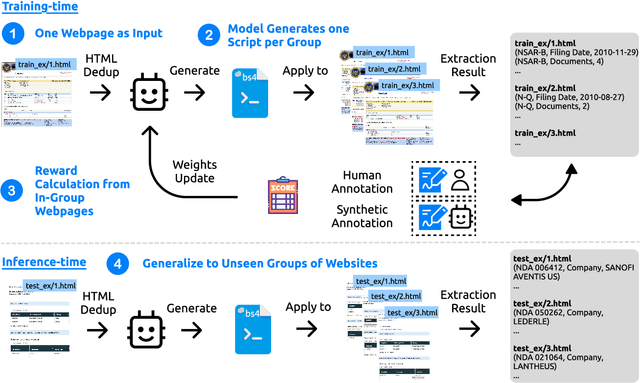
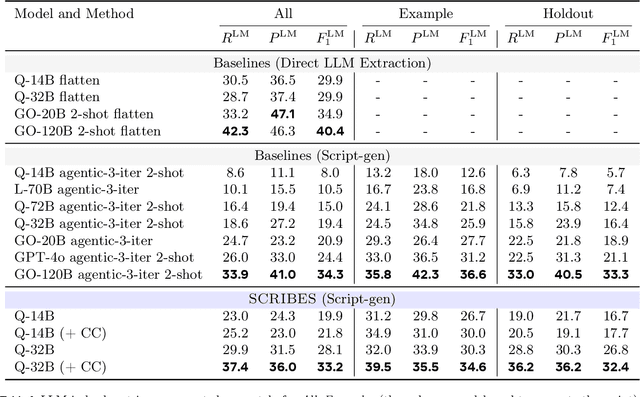


Semi-structured content in HTML tables, lists, and infoboxes accounts for a substantial share of factual data on the web, yet the formatting complicates usage, and reliably extracting structured information from them remains challenging. Existing methods either lack generalization or are resource-intensive due to per-page LLM inference. In this paper, we introduce SCRIBES (SCRIpt-Based Semi-Structured Content Extraction at Web-Scale), a novel reinforcement learning framework that leverages layout similarity across webpages within the same site as a reward signal. Instead of processing each page individually, SCRIBES generates reusable extraction scripts that can be applied to groups of structurally similar webpages. Our approach further improves by iteratively training on synthetic annotations from in-the-wild CommonCrawl data. Experiments show that our approach outperforms strong baselines by over 13% in script quality and boosts downstream question answering accuracy by more than 4% for GPT-4o, enabling scalable and resource-efficient web information extraction.
A Study of the Removability of Speaker-Adversarial Perturbations
Oct 10, 2025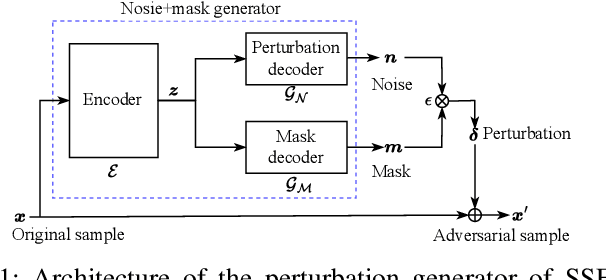
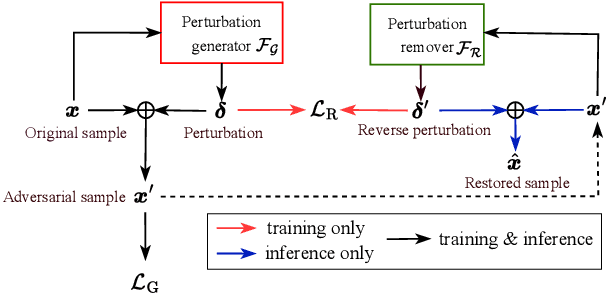
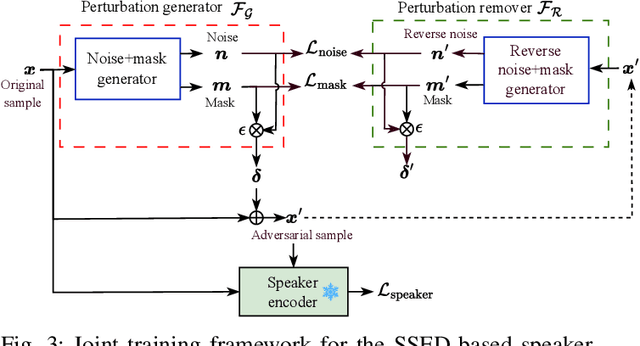

Recent advancements in adversarial attacks have demonstrated their effectiveness in misleading speaker recognition models, making wrong predictions about speaker identities. On the other hand, defense techniques against speaker-adversarial attacks focus on reducing the effects of speaker-adversarial perturbations on speaker attribute extraction. These techniques do not seek to fully remove the perturbations and restore the original speech. To this end, this paper studies the removability of speaker-adversarial perturbations. Specifically, the investigation is conducted assuming various degrees of awareness of the perturbation generator across three scenarios: ignorant, semi-informed, and well-informed. Besides, we consider both the optimization-based and feedforward perturbation generation methods. Experiments conducted on the LibriSpeech dataset demonstrated that: 1) in the ignorant scenario, speaker-adversarial perturbations cannot be eliminated, although their impact on speaker attribute extraction is reduced, 2) in the semi-informed scenario, the speaker-adversarial perturbations cannot be fully removed, while those generated by the feedforward model can be considerably reduced, and 3) in the well-informed scenario, speaker-adversarial perturbations are nearly eliminated, allowing for the restoration of the original speech. Audio samples can be found in https://voiceprivacy.github.io/Perturbation-Generation-Removal/.
 Add to Chrome
Add to Chrome Add to Firefox
Add to Firefox Add to Edge
Add to Edge